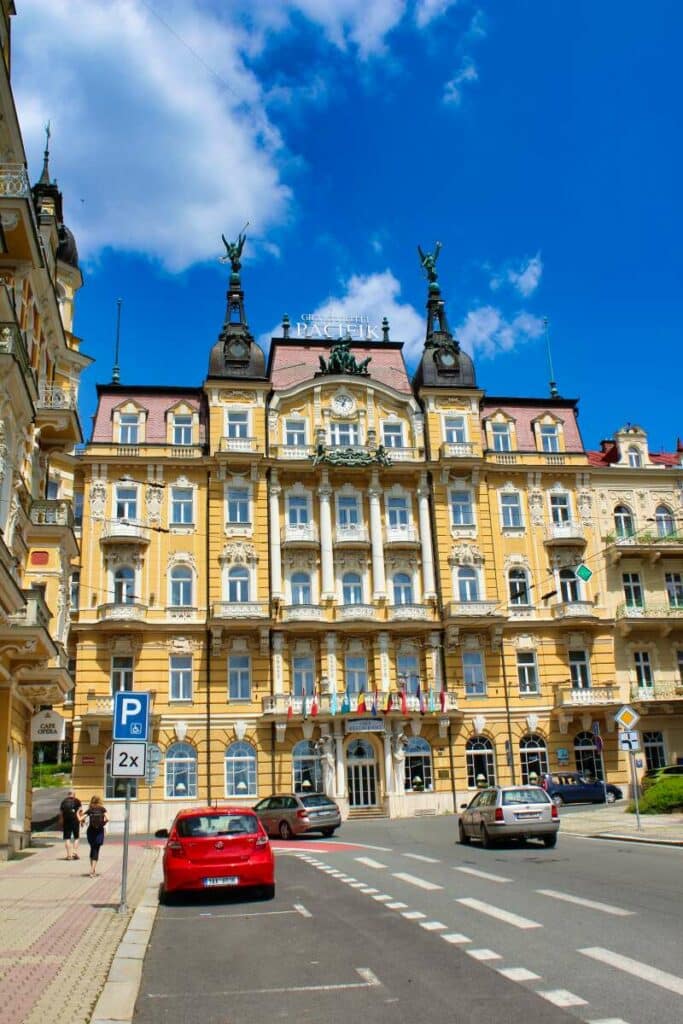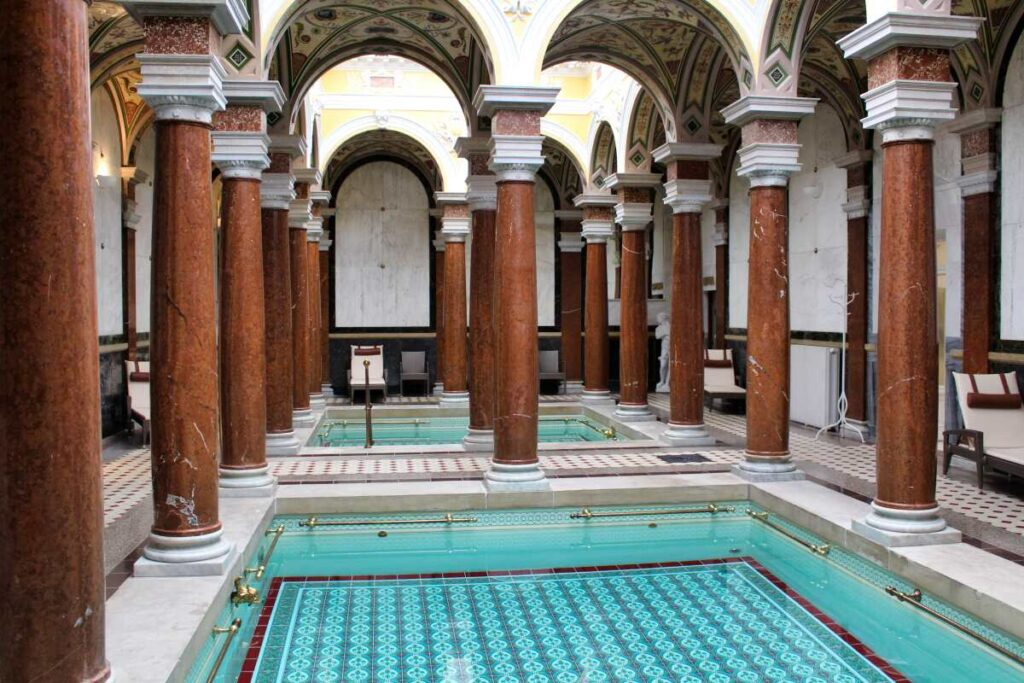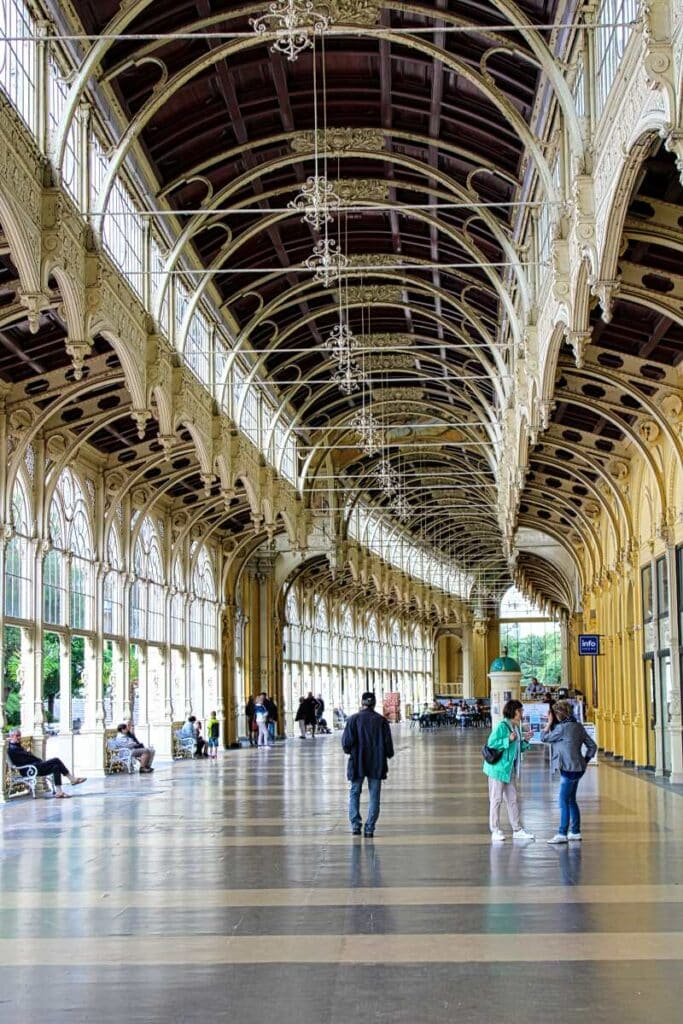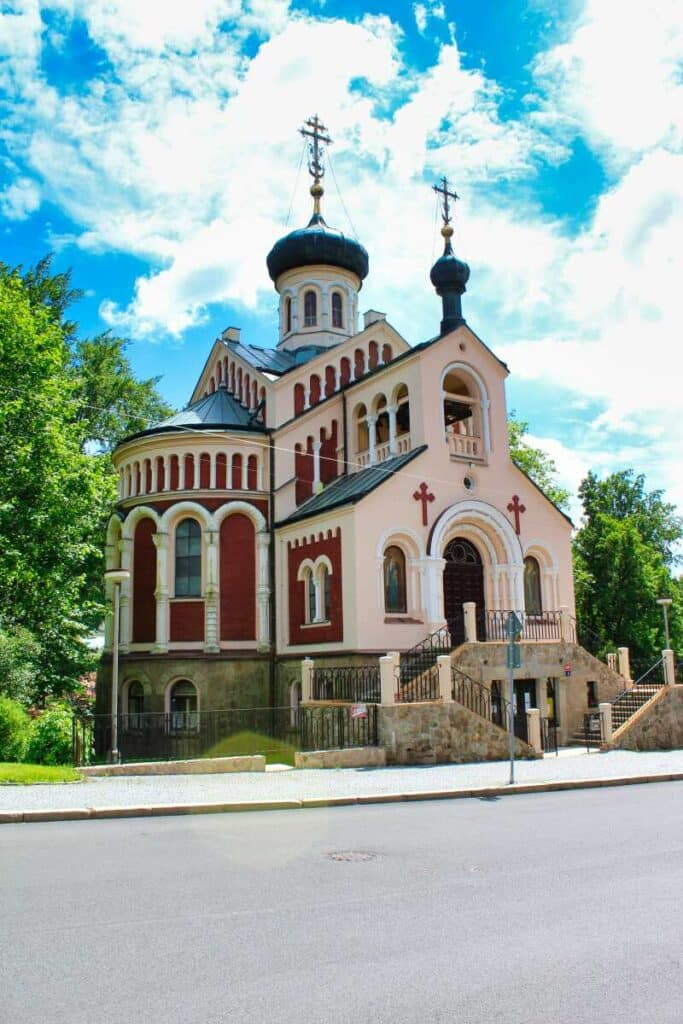After we have already been to the Bohemian Spa Triangle in the far west of the Czech Republic twice and presented Franzensbad and Karlsbad to you in detail, we are taking you to Mariánské Lázně today. But before we present you the most beautiful Mariánské Lázně sights, we want to introduce you to the city first.
This is Mariánské Lázně
The tranquil Mariánské Lázně (the town has only 13,000 inhabitants) has existed for hundreds of years, but like the other spas in the Bohemian Spa Triangle, it experienced its heyday only in the 19th century. At that time, the wonderful parks and magnificent villas and hotels that make Mariánské Lázně so distinctive even today were created. Many consider Mariánské Lázně to be the most beautiful of the three spa cities, partly because it is cozier than the much larger Karlovy Vary, but at the same time seems less provincial than Františkovy Lázně.
Due to its location in a valley, the center is very compact, the long national road leads to the small spa district, which can be fully explored during a one-hour walk. What makes Mariánské Lázně so appealing is its immediate surroundings; numerous hiking trails crisscross the forests here and open up many beautiful vantage points. In a way, they fulfill the functions of extensive spa parks, such as those found in Františkovy Lázn and Western European spas.

Mariánské Lázně was appreciated by famous personalities such as Goethe, Chopin, Kafka, Nietzsche, Twain, Edison, Freud, Nobel, Gogol and several crowned heads. King Edward VII stayed here every year for the cure, once there was even a meeting with Emperor Franz Joseph. Edward VII once wrote about the city: “I have traveled all over India, Ceylon, all the spa towns of Europe, but nowhere in the world has the poetry of magnificent nature so captured my heart as here in Mariánské Lázně”. The city also made a special impression on Richard Wagner, who worked here on his operas “Lohengrin” and “Die Meistersinger von Nürnberg”.

Main Avenue
For about 2.5 kilometers, Hlavní třída (Main Avenue) leads from the train station to the end of the spa district, and a walk there from the train station is not very spectacular at first, but then becomes more and more interesting as the density of cafés, restaurants and small stores increases and finally the magnificent spa district is reached. On the main avenue you can always make small detours into various parks or side streets or let your gaze wander up the slopes to the left and right, where with every meter more and more magnificent villas from the time around 1900 appear and you can let the magic of Mariánské Lázně work its magic on you.
The end of the street is marked by the magnificent Hotel Pacifik with its two Nike figures on the tops of the turrets on both sides of the main facade decorated with wonderful stuccoes. On the left, there is also a magnificent building, the Hotel Zvon.

Václav Skalník Park and New Bath
Mariánské Lázně has only one real spa park, but it is really worth seeing. It is located to the right of the main avenue just before it ends. Numerous sculptures, benches for resting, busts of famous personalities (including statues of Emperor Franz Joseph and King Edward VII, who met here), two beautiful ponds with fountains and the soothing murmur of the Úšovický potok make the area one of the most popular places in the city.
Here you can also find, among other things, a dendrological trail, a drinking fountain with water from the Balbín spring and a bust to Vaclav Skalník. Mariánské Lázně owes its structure to the landscape gardener who came from Prague. He came up with the idea of grouping magnificent buildings around a central park.

At the southeastern end of Skalník Park stands the most representative spa hotel in the entire Spa Triangle. The New Bath (Nové Lázne) was opened in 1896. In parts, the New Baths, which today as then houses a luxury spa hotel, still appears virtually unchanged. Three rooms in particular are among the most beautiful Mariánské Lázně has to offer: The King’s Cabin was furnished especially for the English King Edward VII, who visited Mariánské Lázně (or Marienbad, as it was called in Austrian times) nine times for a cure.
Here you will find not only a lot of marble, but also a sitting scale, which was used for the treatment of the overweight spa guest. Just as beautiful as the King’s Cabin is the Emperor’s Cabin, which has similar furnishings and was furnished for Emperor Franz Joseph I. However, the most beautiful space of the complex is the Roman bath. Divided into a hot and cold water area, the bathroom was designed by Josef Schaffner and features twenty-one red Tuscan columns, ceiling murals and natural daylight.
Goethe House
During his last visit to Mariánské Lázně, Goethe lived for almost two months in the house, which at that time still bore the name “Zur Goldenen Traube”. Today, the famous poet prince is commemorated by an exhibition that includes portraits made by him, furniture of the time and a page of Goethe’s herbarium with plants he had collected in the surroundings of Mariánské Lázně. Much space is also given to the personalities of Mariánské Lázně of that time, with whom Goethe socialized. You can also admire an exhibition on the history of the town, which also informs you about the history of the Cheb region, including the peasantry and the development of the spa industry in the region over time.

Singing fountain
In Mariánské Lázně there is a fountain that can sing! Well, almost at least. 250 jets of water shooting up to six meters into the air from a stylized flower in the warm season create the ideal setting for the relaxing sounds that accompany the water play of the “Zpívající fontána” (Singing Fountain). The “game plan” includes classical music as well as modern hits. At every odd hour, the spa guests gather around the pool, which is not exactly small with a diameter of 20 meters and was only put into operation in 1986. Whether during the day or in the evening (then with beautiful lighting): The Singing Fountain overlooking the main colonnade is the secret star of the place and is one of the most photographed sights of the city.

Main Colonnade
Directly behind the Singing Fountain is the Main Colonnade (Hlavní kolonáda), undisputedly the most beautiful sight in the city. It was designed by the Viennese architects Miksch and Niedzielski in the neo-baroque style. The 119 meter long, cast-iron building runs starting in a slight curve to the source of the cross and is decorated all over.

Inside, the walking hall has a coffered wooden ceiling, interrupted only occasionally by wonderful frescoes that symbolize man’s dream of flying. The work of the artist Josef Vyleťal was created in the 1970s, but it corresponds perfectly with its Art Nouveau and Neo-Baroque surroundings. Inside the colonnade there is a small stage where concerts are regularly held in the summer. At the northern end of the colonnade stands another beautiful building, the Colonnade of the Cross Spring, named after a wooden cross that used to stand nearby here. The cool water of the Cross spring here is a relatively strong laxative, so one should better restrain oneself from drinking the water.

Vladimir Church
The church, built between 1900 and 1902 under Gustav Wiedermann (who also designed churches in other towns of the spa triangle), is one of the most beautiful places of worship in the town. The exotic looking exterior is surpassed inside by the decoration with gold and cobalt, especially the iconostasis is a real eye-catcher. It is made of majolka tiles and separates the worldly from the divine sphere.
In 1900 it was shown at the World’s Fair in Paris, where it won a prize. The church was donated by a Russian general. Since the region was popular with Russian spa guests, donations were always raised to further decorate the church. Since the Russian invasion of Ukraine, the number of Russian spa guests has noticeably decreased.

Ferdinand Spring Colonnade
South of the spa district, but easily accessible from it within a leisurely walk, is the Ferdinand Spring. The spring was probably discovered already in the 16th century. King Ferdinand had it examined in order to obtain common salt from it (which was not crowned with success, because this water also has a strong laxative effect). In the early 19th century, under Josef Esch, it was covered with an elongated colonnade. The colonnade is made up of three parts, two pavilions on the sides and a central gloriette with a dome top with Doric columns. The spring is surrounded by the spacious Auschowitz Park (Úšovický park), where also the wooden pavilion of the Rudolf Spring is located.

Hamelika Tower
Not all of the Mariánské Lázně attractions are as centrally located as the following. It takes about 20 minutes to walk from the center on the King Edward Route along a quiet road winding up the hill to Hamelika Tower. The 20 m high tower has a diameter of 5.5 m and stands in the middle of a forest. It was built in 1876 under the local architect Friedrich Zickler in the style of a Romanesque castle ruin, and from the outside you might think it is much older and dates back to the Middle Ages.

You could climb the tower around the clock and enjoy the view. Unfortunately, some trees block the view of a large part of the spa district, but this is compensated for by the panoramic view to the west of the Bohemian Forest. Almost directly behind the spa district you can make out Cheb in the distance on a clear day.

Boheminium
From Hamelika Tower it is not far to a small recreational park following a deer enclosure, one of the most unusual Mariánské Lázně sights. The Boheminium Park is one of the largest miniature parks in Europe. On an area of 6 hectares, visitors can expect to see the Czech Republic in miniature. Around 75 models on a scale of 1 : 25 present the country’s most important sights, while information boards tell visitors all about the country’s most architecturally attractive places. In addition to the models, there is also a pony farm and a large playground. After the hike you can strengthen yourself in a barbecue and a cafe.
Excursion tips Mariánské Lázně
You have had enough of the Mariánské Lázně sights and want to take a trip to the surroundings? No problem, because around Mariánské Lázně there is a lot to discover!

Kynžvart Castle
In the 16th century, a Renaissance castle was built at the gates of the town, which, however, would later see its most famous inhabitant: Klemens Wenzel Lothar von Metternich, the most famous politician of his time, opponent of Napoleon and organizer of the Congress of Vienna. Today you can stroll through the magnificent chambers of the Metternich family and admire gifts from tsars, kings and popes, marvel at objects from Napoleon’s personal possessions and wander through the prestigious study, library and dining rooms. Around the palace, the Viennese court gardener Riedl laid out a 265-hectare English landscape park.

Mariánské Lázně sights – Kladská
In the Slavkovský les forest in the surroundings of Mariánské Lázně there is a small nature reserve where you can walk on a 2 km long footbridge through a bog! With a little luck you might spot a wild deer, lynx or wild boar, but even without these animals a walk around the lake with its numerous information boards is a wonderful experience. The many wooden houses in the Swiss-Tyrolean style are also beautiful to look at. By the way, you can stop in one of these houses. In the old Auerhahn you can enjoy delicious dishes of the Czech cuisine!

Teplá Monastery
In the 13th century this monastery complex, Klášter Teplá, was built. Over the centuries, the monastery grew into a huge complex that includes a magnificent Baroque church, several museum halls and, in particular, a Baroque library that usually takes visitors’ breath away. The monastery’s collection of mainly German and Latin works comprises over 100,000 books, and a full 30,000 of them are on display in the large library hall. Attached is also a nice monastery store with products from the monastery and other abbeys.
How did you like the article about Mariánské Lázně Which other Mariánské Lázně sights do you know? Let us know and drop us a comment!

